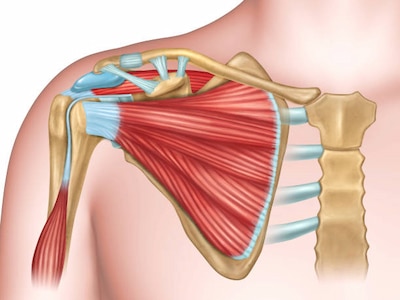The term “arthritis” means joint irritation — and if you suffer from shoulder arthritis in Houston, it also means trouble for your quality of life. When inflammation and deterioration reduce your shoulder’s range of motion, you lose much of your arm’s function, since this joint allows your upper arm to perform its countless daily tasks. Let’s explore the challenge of shoulder arthritis, from its causes and symptoms to the many available treatment options currently available.
Anatomy of the Shoulder Joint
The shoulder joint features a ball-and-socket arrangement. The scapula (shoulder blade) includes a socket-like space that accommodates the ball of the humerus, or upper arm bone. Cushioning cartilage and fluid in the joint capsule prevent friction when the humerus rotates in its socket.
The shoulder also contains a set of muscles and ligaments collectively referred to as the rotator cuff. The ligaments are attached to the muscles at one end and to the humerus at the other end. When you activate the muscles, the ligaments pull on the humerus to make your arm move.
Types of Shoulder Arthritis
Several types of arthritis can affect shoulder movement and comfort. The most common type, osteoarthritis, involves the deterioration of the cartilage lining the joint components. As the cartilage breaks down, friction increases, making the shoulder stiff and painful.
Your shoulder can also develop rheumatoid arthritis. In this condition, the immune system mistakenly attacks the shoulder components, creating swelling, pain, and deformity.
Other forms of arthritis can also afflict the shoulder. Examples include rotator cuff tear arthropathy, osteonecrosis (bone death), and arthritis resulting from a traumatic injury.
Causes of Shoulder Arthritis
Age-related degeneration usually causes osteoarthritis, although previous shoulder injuries can lead to both osteoarthritis and post-traumatic arthritis. Systemic autoimmune conditions such as lupus are commonly associated with rheumatoid arthritis. Genetics and family history can also play a role; in fact, some people suffer from congenital or juvenile arthritis.
Risk Factors for Shoulder Arthritis
Many life circumstances count as risk factors for arthritis of the shoulder. Examples include:
- Age and gender – Women and older individuals have an elevated risk for arthritis of the shoulder.
- Repetitive overuse – Constant use of the shoulder joint can trigger inflammation and cause joint components to wear out more rapidly.
- Sports and physical activities – Sports that require lots of throwing or swinging motions can hasten the development of arthritis.
- Occupation-related risks – Any job that places undue stress on your shoulder joint can promote arthritis.
Recognizing the Symptoms
If you have arthritis in your shoulder, you may experience persistent shoulder pain and a limited range of shoulder motion. Swelling may be evident alongside this joint stiffness. The muscles of the shoulder may grow weak, further limiting the use of your arm.
Diagnosis
Orthopedic specialists can administer numerous tests to determine whether your shoulder has developed arthritis. Your medical history can reveal any inherited tendencies toward arthritis, while a physical examination of your shoulder mobility and symptoms can show the severity of your condition. X-rays, CT scans, and MRIs can provide pictures of the internal damage.
In addition to these tests, your doctor may perform a procedure called joint aspiration, taking fluid from your shoulder joint and examining the fluid for signs of arthritis. Blood tests can display antibodies associated with rheumatoid arthritis.
Treatment Options
Treatment for shoulder arthritis can vary according to the type and severity of the arthritis. Non-surgical treatment methods include non-prescription anti-inflammatory drugs, physical therapy exercises, and corticosteroid injections. Severe, non-responsive arthritis may require surgery. Surgical options include:
- Shoulder arthroscopy: The surgeon uses elongated instruments to examine the joint with a camera and remove bits of cartilage or bone as non-invasively as possible.
- Shoulder joint reconstruction: The surgeon either resurfaces the ball of the humerus or removes it and installs a metal replacement.
When to Seek Professional Help
If over-the-counter medications and gentle exercise can’t ease your arthritis symptoms, or if you notice the symptoms growing worse, you should seek professional help. Timely diagnosis and intervention can spare you from a great deal of pain and suffering. It might even make the difference between conservative treatment and surgery.
Get Timely Treatment for Shoulder Arthritis
Arthritis in your shoulder joint can render you incapable of your favorite activities — but it doesn’t have to if you get it detected early. Pay attention to your symptoms and contact a Houston shoulder arthritis expert for medical guidance.

